Tax Impact, Market Dynamics, and Government Consolidation in Australia
VerifiedAdded on 2023/06/14
|13
|2759
|56
Essay
AI Summary
This economics essay provides a comprehensive analysis of various topics, starting with an examination of the excise tax on cigarettes in Australia and its impact on consumers and sellers, using the demand-supply framework to illustrate tax incidence. It then delves into market structures, contrasting monopolistic competition with oligopoly, highlighting differences in the number of sellers, market share, entry barriers, and long-run profitability. The essay further explores the economic rationale behind government mergers in Australia, focusing on economies of scale, reduced administration costs, economies of scope, and strategic capacity improvements. The discussion includes the potential for cost reduction and increased efficiency in providing public services through larger, consolidated government bodies. The assignment concludes by arguing that the primary justification for larger government bodies lies in improved viability and capacity rather than direct cost savings.
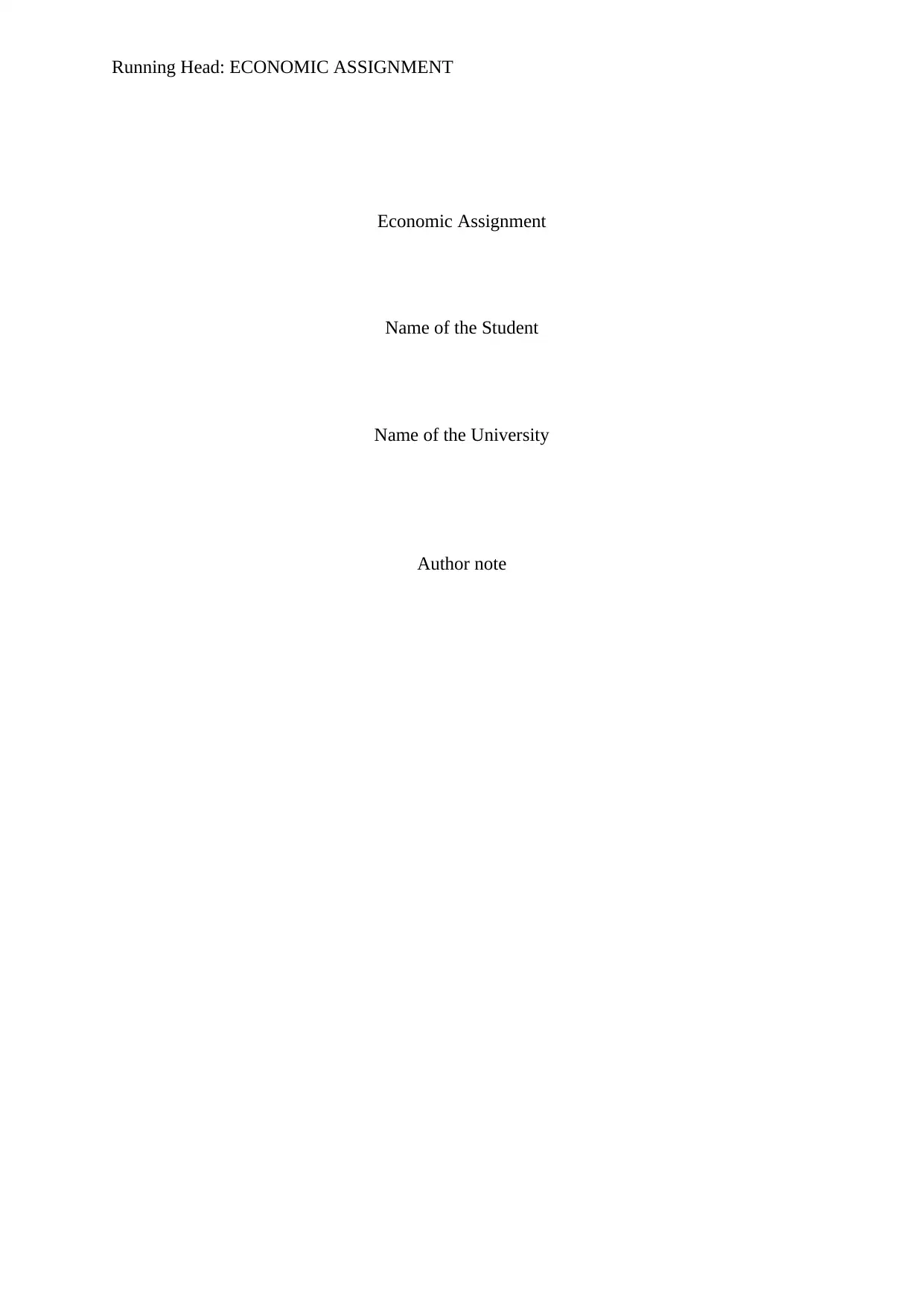
Running Head: ECONOMIC ASSIGNMENT
Economic Assignment
Name of the Student
Name of the University
Author note
Economic Assignment
Name of the Student
Name of the University
Author note
Paraphrase This Document
Need a fresh take? Get an instant paraphrase of this document with our AI Paraphraser
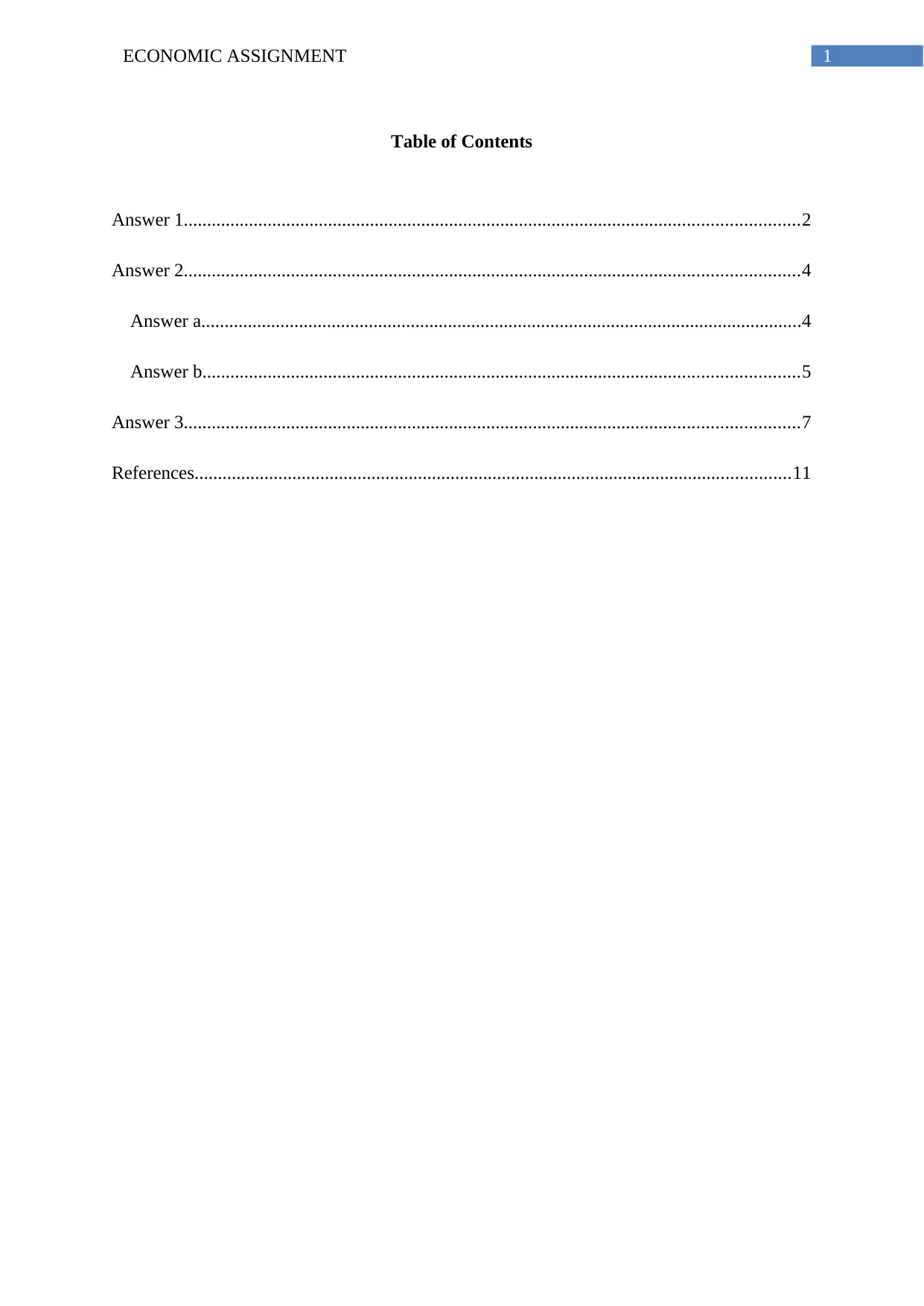
1ECONOMIC ASSIGNMENT
Table of Contents
Answer 1....................................................................................................................................2
Answer 2....................................................................................................................................4
Answer a.................................................................................................................................4
Answer b................................................................................................................................5
Answer 3....................................................................................................................................7
References................................................................................................................................11
Table of Contents
Answer 1....................................................................................................................................2
Answer 2....................................................................................................................................4
Answer a.................................................................................................................................4
Answer b................................................................................................................................5
Answer 3....................................................................................................................................7
References................................................................................................................................11
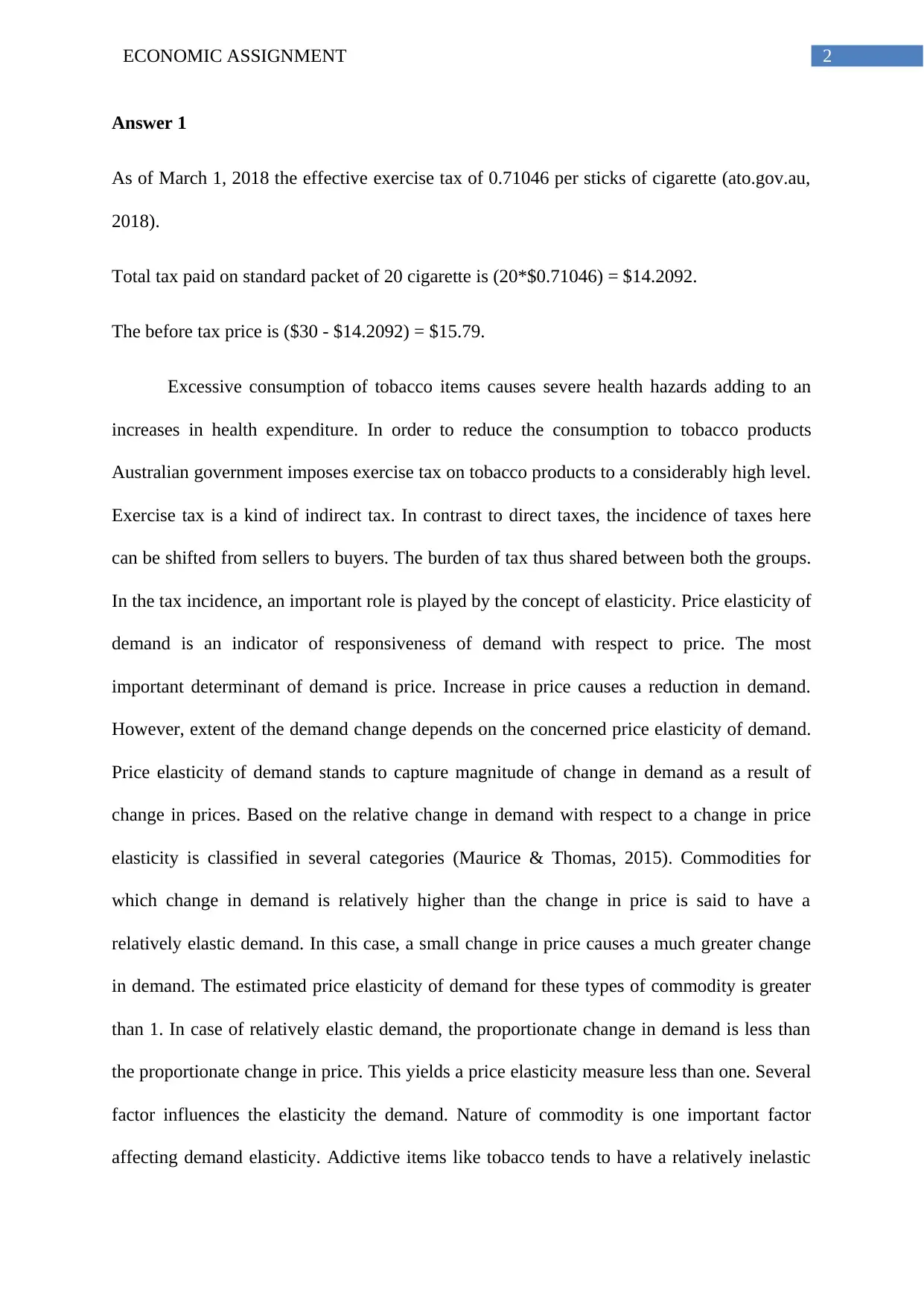
2ECONOMIC ASSIGNMENT
Answer 1
As of March 1, 2018 the effective exercise tax of 0.71046 per sticks of cigarette (ato.gov.au,
2018).
Total tax paid on standard packet of 20 cigarette is (20*$0.71046) = $14.2092.
The before tax price is ($30 - $14.2092) = $15.79.
Excessive consumption of tobacco items causes severe health hazards adding to an
increases in health expenditure. In order to reduce the consumption to tobacco products
Australian government imposes exercise tax on tobacco products to a considerably high level.
Exercise tax is a kind of indirect tax. In contrast to direct taxes, the incidence of taxes here
can be shifted from sellers to buyers. The burden of tax thus shared between both the groups.
In the tax incidence, an important role is played by the concept of elasticity. Price elasticity of
demand is an indicator of responsiveness of demand with respect to price. The most
important determinant of demand is price. Increase in price causes a reduction in demand.
However, extent of the demand change depends on the concerned price elasticity of demand.
Price elasticity of demand stands to capture magnitude of change in demand as a result of
change in prices. Based on the relative change in demand with respect to a change in price
elasticity is classified in several categories (Maurice & Thomas, 2015). Commodities for
which change in demand is relatively higher than the change in price is said to have a
relatively elastic demand. In this case, a small change in price causes a much greater change
in demand. The estimated price elasticity of demand for these types of commodity is greater
than 1. In case of relatively elastic demand, the proportionate change in demand is less than
the proportionate change in price. This yields a price elasticity measure less than one. Several
factor influences the elasticity the demand. Nature of commodity is one important factor
affecting demand elasticity. Addictive items like tobacco tends to have a relatively inelastic
Answer 1
As of March 1, 2018 the effective exercise tax of 0.71046 per sticks of cigarette (ato.gov.au,
2018).
Total tax paid on standard packet of 20 cigarette is (20*$0.71046) = $14.2092.
The before tax price is ($30 - $14.2092) = $15.79.
Excessive consumption of tobacco items causes severe health hazards adding to an
increases in health expenditure. In order to reduce the consumption to tobacco products
Australian government imposes exercise tax on tobacco products to a considerably high level.
Exercise tax is a kind of indirect tax. In contrast to direct taxes, the incidence of taxes here
can be shifted from sellers to buyers. The burden of tax thus shared between both the groups.
In the tax incidence, an important role is played by the concept of elasticity. Price elasticity of
demand is an indicator of responsiveness of demand with respect to price. The most
important determinant of demand is price. Increase in price causes a reduction in demand.
However, extent of the demand change depends on the concerned price elasticity of demand.
Price elasticity of demand stands to capture magnitude of change in demand as a result of
change in prices. Based on the relative change in demand with respect to a change in price
elasticity is classified in several categories (Maurice & Thomas, 2015). Commodities for
which change in demand is relatively higher than the change in price is said to have a
relatively elastic demand. In this case, a small change in price causes a much greater change
in demand. The estimated price elasticity of demand for these types of commodity is greater
than 1. In case of relatively elastic demand, the proportionate change in demand is less than
the proportionate change in price. This yields a price elasticity measure less than one. Several
factor influences the elasticity the demand. Nature of commodity is one important factor
affecting demand elasticity. Addictive items like tobacco tends to have a relatively inelastic
⊘ This is a preview!⊘
Do you want full access?
Subscribe today to unlock all pages.

Trusted by 1+ million students worldwide
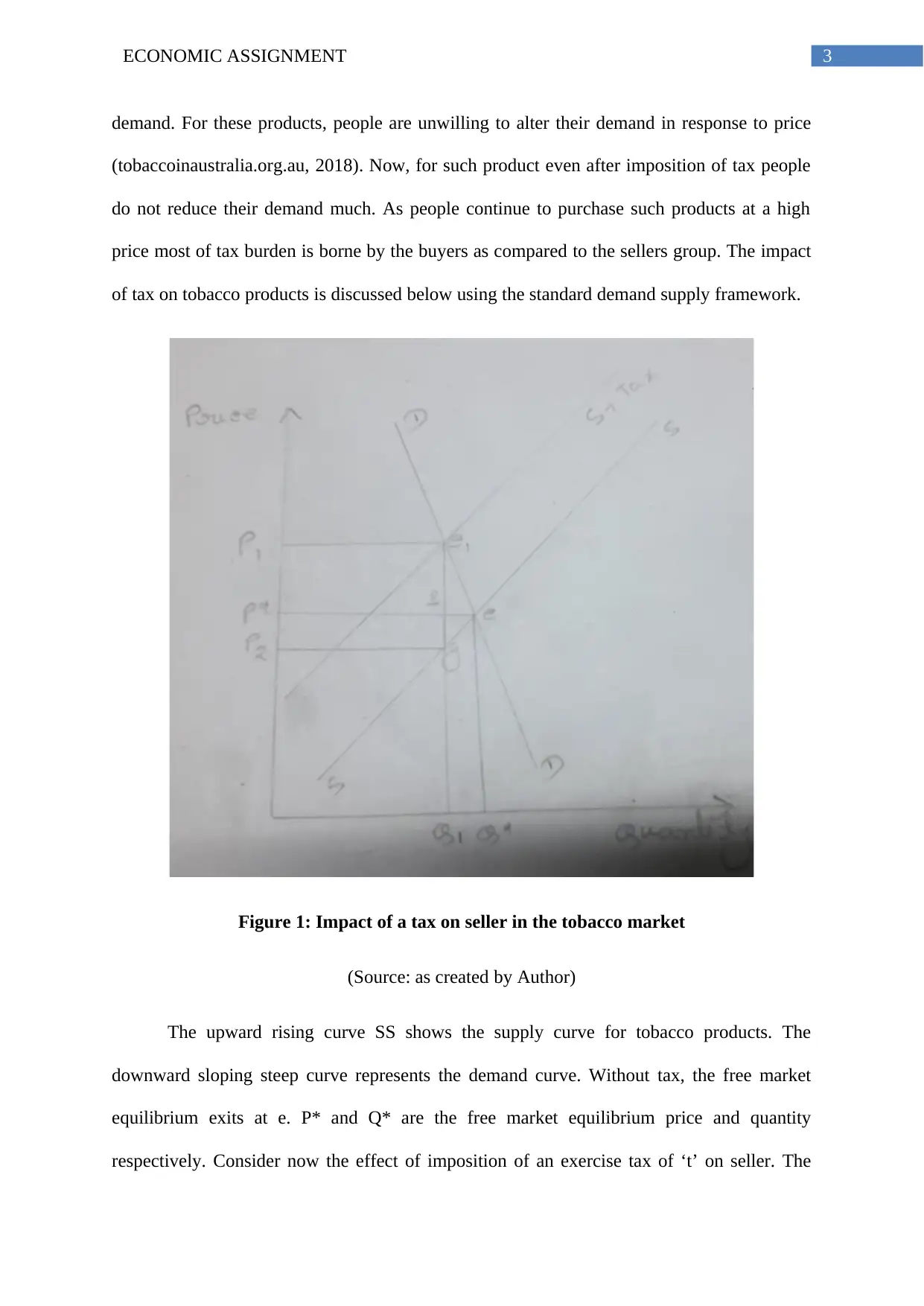
3ECONOMIC ASSIGNMENT
demand. For these products, people are unwilling to alter their demand in response to price
(tobaccoinaustralia.org.au, 2018). Now, for such product even after imposition of tax people
do not reduce their demand much. As people continue to purchase such products at a high
price most of tax burden is borne by the buyers as compared to the sellers group. The impact
of tax on tobacco products is discussed below using the standard demand supply framework.
Figure 1: Impact of a tax on seller in the tobacco market
(Source: as created by Author)
The upward rising curve SS shows the supply curve for tobacco products. The
downward sloping steep curve represents the demand curve. Without tax, the free market
equilibrium exits at e. P* and Q* are the free market equilibrium price and quantity
respectively. Consider now the effect of imposition of an exercise tax of ‘t’ on seller. The
demand. For these products, people are unwilling to alter their demand in response to price
(tobaccoinaustralia.org.au, 2018). Now, for such product even after imposition of tax people
do not reduce their demand much. As people continue to purchase such products at a high
price most of tax burden is borne by the buyers as compared to the sellers group. The impact
of tax on tobacco products is discussed below using the standard demand supply framework.
Figure 1: Impact of a tax on seller in the tobacco market
(Source: as created by Author)
The upward rising curve SS shows the supply curve for tobacco products. The
downward sloping steep curve represents the demand curve. Without tax, the free market
equilibrium exits at e. P* and Q* are the free market equilibrium price and quantity
respectively. Consider now the effect of imposition of an exercise tax of ‘t’ on seller. The
Paraphrase This Document
Need a fresh take? Get an instant paraphrase of this document with our AI Paraphraser
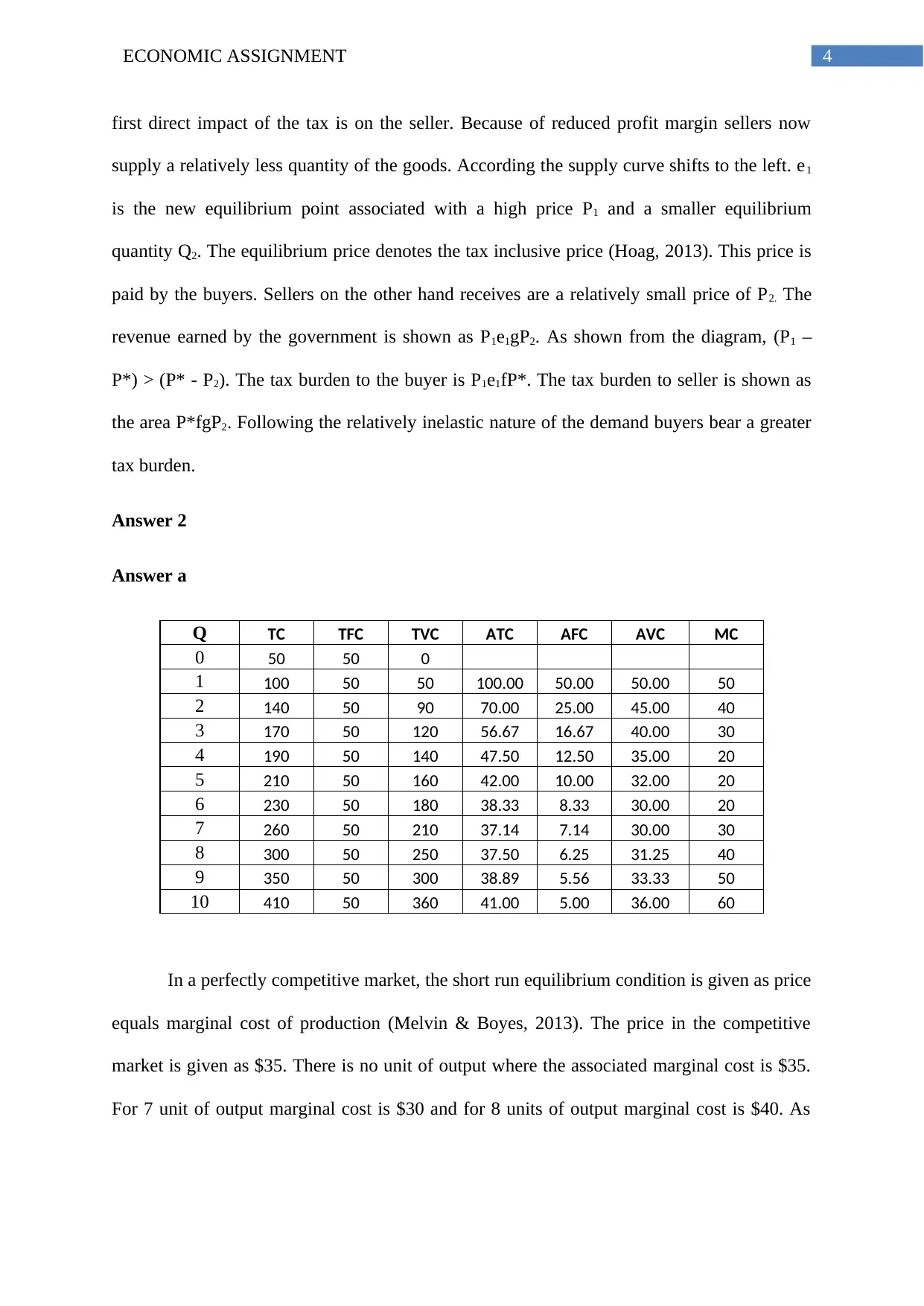
4ECONOMIC ASSIGNMENT
first direct impact of the tax is on the seller. Because of reduced profit margin sellers now
supply a relatively less quantity of the goods. According the supply curve shifts to the left. e1
is the new equilibrium point associated with a high price P1 and a smaller equilibrium
quantity Q2. The equilibrium price denotes the tax inclusive price (Hoag, 2013). This price is
paid by the buyers. Sellers on the other hand receives are a relatively small price of P2. The
revenue earned by the government is shown as P1e1gP2. As shown from the diagram, (P1 –
P*) > (P* - P2). The tax burden to the buyer is P1e1fP*. The tax burden to seller is shown as
the area P*fgP2. Following the relatively inelastic nature of the demand buyers bear a greater
tax burden.
Answer 2
Answer a
Q TC TFC TVC ATC AFC AVC MC
0 50 50 0
1 100 50 50 100.00 50.00 50.00 50
2 140 50 90 70.00 25.00 45.00 40
3 170 50 120 56.67 16.67 40.00 30
4 190 50 140 47.50 12.50 35.00 20
5 210 50 160 42.00 10.00 32.00 20
6 230 50 180 38.33 8.33 30.00 20
7 260 50 210 37.14 7.14 30.00 30
8 300 50 250 37.50 6.25 31.25 40
9 350 50 300 38.89 5.56 33.33 50
10 410 50 360 41.00 5.00 36.00 60
In a perfectly competitive market, the short run equilibrium condition is given as price
equals marginal cost of production (Melvin & Boyes, 2013). The price in the competitive
market is given as $35. There is no unit of output where the associated marginal cost is $35.
For 7 unit of output marginal cost is $30 and for 8 units of output marginal cost is $40. As
first direct impact of the tax is on the seller. Because of reduced profit margin sellers now
supply a relatively less quantity of the goods. According the supply curve shifts to the left. e1
is the new equilibrium point associated with a high price P1 and a smaller equilibrium
quantity Q2. The equilibrium price denotes the tax inclusive price (Hoag, 2013). This price is
paid by the buyers. Sellers on the other hand receives are a relatively small price of P2. The
revenue earned by the government is shown as P1e1gP2. As shown from the diagram, (P1 –
P*) > (P* - P2). The tax burden to the buyer is P1e1fP*. The tax burden to seller is shown as
the area P*fgP2. Following the relatively inelastic nature of the demand buyers bear a greater
tax burden.
Answer 2
Answer a
Q TC TFC TVC ATC AFC AVC MC
0 50 50 0
1 100 50 50 100.00 50.00 50.00 50
2 140 50 90 70.00 25.00 45.00 40
3 170 50 120 56.67 16.67 40.00 30
4 190 50 140 47.50 12.50 35.00 20
5 210 50 160 42.00 10.00 32.00 20
6 230 50 180 38.33 8.33 30.00 20
7 260 50 210 37.14 7.14 30.00 30
8 300 50 250 37.50 6.25 31.25 40
9 350 50 300 38.89 5.56 33.33 50
10 410 50 360 41.00 5.00 36.00 60
In a perfectly competitive market, the short run equilibrium condition is given as price
equals marginal cost of production (Melvin & Boyes, 2013). The price in the competitive
market is given as $35. There is no unit of output where the associated marginal cost is $35.
For 7 unit of output marginal cost is $30 and for 8 units of output marginal cost is $40. As

5ECONOMIC ASSIGNMENT
marginal cost lies between this range, optimal output is between 7 and 8. Firm in the
perfectly competitive market choses to produce 7.5 units of output in the short run.
As obtained above the price in the short run is less than the average total cost
implying firms in this market incur a short run loss. The price however is higher than average
variable cost implying the firm is operating at the break-even point (Perloff, 2015). In the
short run the firm might continue its operation as long as price is greater than minimum
average variable cost. If the long run price is continued to $35, then price still remains below
the average total cost. The loss making firms in the long run exists the industry.
Answer b
In economies, market in economics is defined as an arrangement where buyers and
sellers come in close contact either directly or indirectly sell and buy commodities. Based on
number of sellers and buyers present in the markets are of four types (REA, 2013). These are
perfectly competitive market, monopoly, oligopoly and monopolistic competition.
The monopolistically competitive market is a market model where large number of
seller provide a differentiated product in the market. In this form of market, each seller has
multiple competitor but each one of them sells a slightly different products. Each firms takes
is own decision like a monopolist. Extensive competition exists among different firms in the
industry (Arthur, 2018). Products in the markets can be differentiated in any of four ways –
marketing differentiation, differentiation in human capital, physical product differentiation
and differentiation through distribution. Some common examples of monopolistically
competitive market include coffee shops, hotel or restaurant business, automotive service
companies, grocery stores and others.
Another form of imperfectly competitive market is oligopoly market. In thus form of
market few large sellers operate in the market occupying a significantly large share in the
marginal cost lies between this range, optimal output is between 7 and 8. Firm in the
perfectly competitive market choses to produce 7.5 units of output in the short run.
As obtained above the price in the short run is less than the average total cost
implying firms in this market incur a short run loss. The price however is higher than average
variable cost implying the firm is operating at the break-even point (Perloff, 2015). In the
short run the firm might continue its operation as long as price is greater than minimum
average variable cost. If the long run price is continued to $35, then price still remains below
the average total cost. The loss making firms in the long run exists the industry.
Answer b
In economies, market in economics is defined as an arrangement where buyers and
sellers come in close contact either directly or indirectly sell and buy commodities. Based on
number of sellers and buyers present in the markets are of four types (REA, 2013). These are
perfectly competitive market, monopoly, oligopoly and monopolistic competition.
The monopolistically competitive market is a market model where large number of
seller provide a differentiated product in the market. In this form of market, each seller has
multiple competitor but each one of them sells a slightly different products. Each firms takes
is own decision like a monopolist. Extensive competition exists among different firms in the
industry (Arthur, 2018). Products in the markets can be differentiated in any of four ways –
marketing differentiation, differentiation in human capital, physical product differentiation
and differentiation through distribution. Some common examples of monopolistically
competitive market include coffee shops, hotel or restaurant business, automotive service
companies, grocery stores and others.
Another form of imperfectly competitive market is oligopoly market. In thus form of
market few large sellers operate in the market occupying a significantly large share in the
⊘ This is a preview!⊘
Do you want full access?
Subscribe today to unlock all pages.

Trusted by 1+ million students worldwide
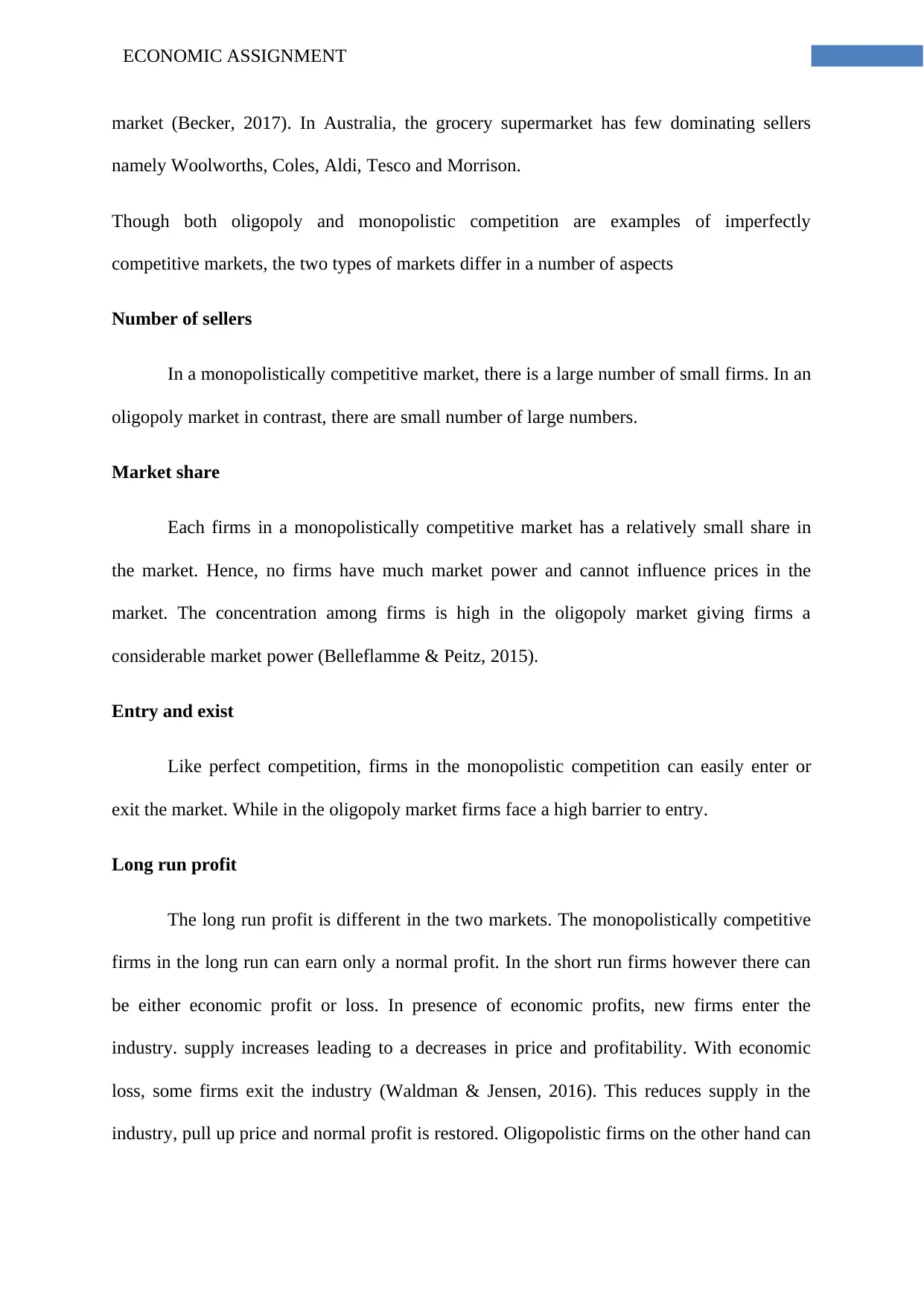
6ECONOMIC ASSIGNMENT
market (Becker, 2017). In Australia, the grocery supermarket has few dominating sellers
namely Woolworths, Coles, Aldi, Tesco and Morrison.
Though both oligopoly and monopolistic competition are examples of imperfectly
competitive markets, the two types of markets differ in a number of aspects
Number of sellers
In a monopolistically competitive market, there is a large number of small firms. In an
oligopoly market in contrast, there are small number of large numbers.
Market share
Each firms in a monopolistically competitive market has a relatively small share in
the market. Hence, no firms have much market power and cannot influence prices in the
market. The concentration among firms is high in the oligopoly market giving firms a
considerable market power (Belleflamme & Peitz, 2015).
Entry and exist
Like perfect competition, firms in the monopolistic competition can easily enter or
exit the market. While in the oligopoly market firms face a high barrier to entry.
Long run profit
The long run profit is different in the two markets. The monopolistically competitive
firms in the long run can earn only a normal profit. In the short run firms however there can
be either economic profit or loss. In presence of economic profits, new firms enter the
industry. supply increases leading to a decreases in price and profitability. With economic
loss, some firms exit the industry (Waldman & Jensen, 2016). This reduces supply in the
industry, pull up price and normal profit is restored. Oligopolistic firms on the other hand can
market (Becker, 2017). In Australia, the grocery supermarket has few dominating sellers
namely Woolworths, Coles, Aldi, Tesco and Morrison.
Though both oligopoly and monopolistic competition are examples of imperfectly
competitive markets, the two types of markets differ in a number of aspects
Number of sellers
In a monopolistically competitive market, there is a large number of small firms. In an
oligopoly market in contrast, there are small number of large numbers.
Market share
Each firms in a monopolistically competitive market has a relatively small share in
the market. Hence, no firms have much market power and cannot influence prices in the
market. The concentration among firms is high in the oligopoly market giving firms a
considerable market power (Belleflamme & Peitz, 2015).
Entry and exist
Like perfect competition, firms in the monopolistic competition can easily enter or
exit the market. While in the oligopoly market firms face a high barrier to entry.
Long run profit
The long run profit is different in the two markets. The monopolistically competitive
firms in the long run can earn only a normal profit. In the short run firms however there can
be either economic profit or loss. In presence of economic profits, new firms enter the
industry. supply increases leading to a decreases in price and profitability. With economic
loss, some firms exit the industry (Waldman & Jensen, 2016). This reduces supply in the
industry, pull up price and normal profit is restored. Oligopolistic firms on the other hand can
Paraphrase This Document
Need a fresh take? Get an instant paraphrase of this document with our AI Paraphraser
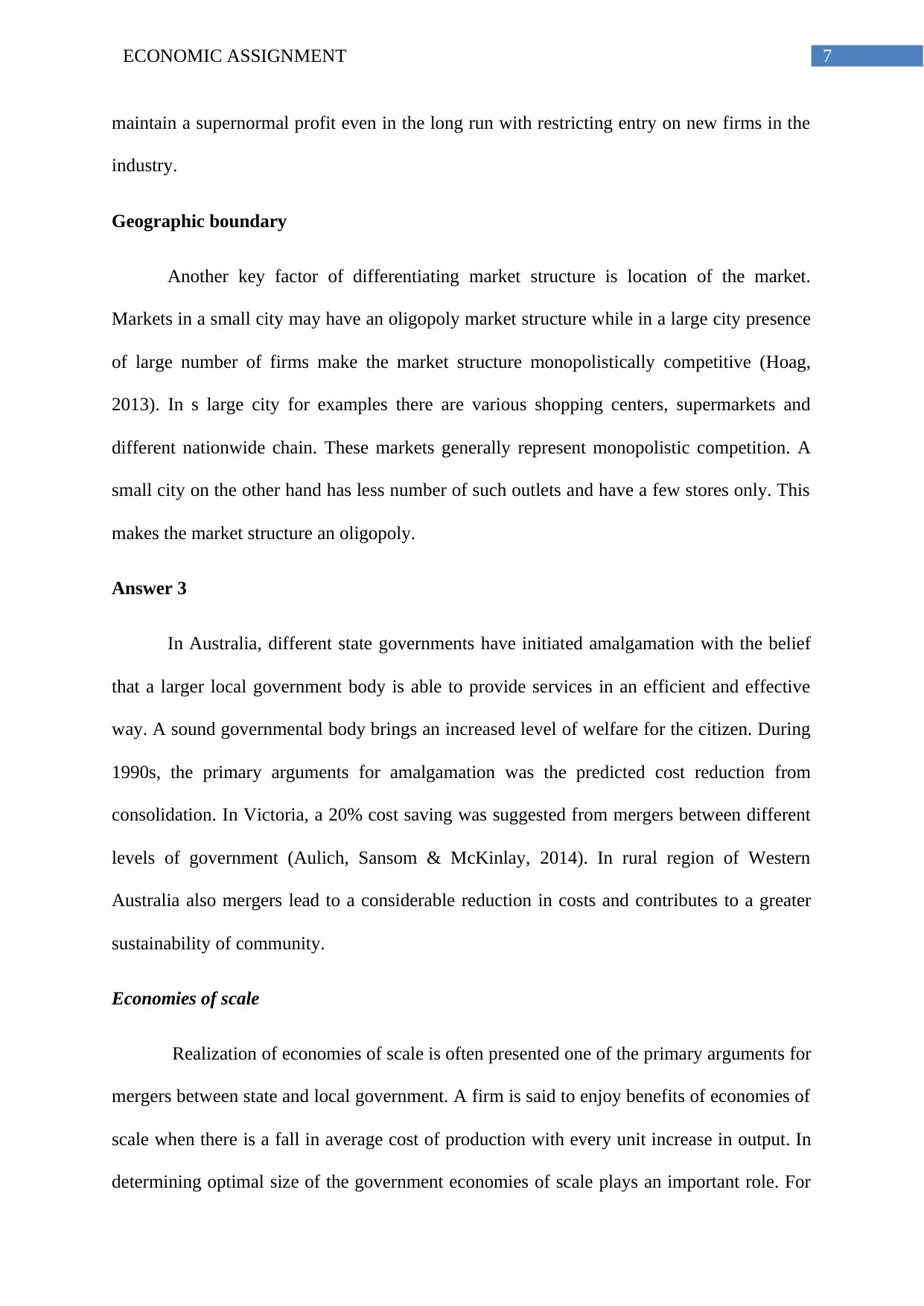
7ECONOMIC ASSIGNMENT
maintain a supernormal profit even in the long run with restricting entry on new firms in the
industry.
Geographic boundary
Another key factor of differentiating market structure is location of the market.
Markets in a small city may have an oligopoly market structure while in a large city presence
of large number of firms make the market structure monopolistically competitive (Hoag,
2013). In s large city for examples there are various shopping centers, supermarkets and
different nationwide chain. These markets generally represent monopolistic competition. A
small city on the other hand has less number of such outlets and have a few stores only. This
makes the market structure an oligopoly.
Answer 3
In Australia, different state governments have initiated amalgamation with the belief
that a larger local government body is able to provide services in an efficient and effective
way. A sound governmental body brings an increased level of welfare for the citizen. During
1990s, the primary arguments for amalgamation was the predicted cost reduction from
consolidation. In Victoria, a 20% cost saving was suggested from mergers between different
levels of government (Aulich, Sansom & McKinlay, 2014). In rural region of Western
Australia also mergers lead to a considerable reduction in costs and contributes to a greater
sustainability of community.
Economies of scale
Realization of economies of scale is often presented one of the primary arguments for
mergers between state and local government. A firm is said to enjoy benefits of economies of
scale when there is a fall in average cost of production with every unit increase in output. In
determining optimal size of the government economies of scale plays an important role. For
maintain a supernormal profit even in the long run with restricting entry on new firms in the
industry.
Geographic boundary
Another key factor of differentiating market structure is location of the market.
Markets in a small city may have an oligopoly market structure while in a large city presence
of large number of firms make the market structure monopolistically competitive (Hoag,
2013). In s large city for examples there are various shopping centers, supermarkets and
different nationwide chain. These markets generally represent monopolistic competition. A
small city on the other hand has less number of such outlets and have a few stores only. This
makes the market structure an oligopoly.
Answer 3
In Australia, different state governments have initiated amalgamation with the belief
that a larger local government body is able to provide services in an efficient and effective
way. A sound governmental body brings an increased level of welfare for the citizen. During
1990s, the primary arguments for amalgamation was the predicted cost reduction from
consolidation. In Victoria, a 20% cost saving was suggested from mergers between different
levels of government (Aulich, Sansom & McKinlay, 2014). In rural region of Western
Australia also mergers lead to a considerable reduction in costs and contributes to a greater
sustainability of community.
Economies of scale
Realization of economies of scale is often presented one of the primary arguments for
mergers between state and local government. A firm is said to enjoy benefits of economies of
scale when there is a fall in average cost of production with every unit increase in output. In
determining optimal size of the government economies of scale plays an important role. For

8ECONOMIC ASSIGNMENT
public goods and services, economies of scale lead to a reduction in per head cost of
providing such services with increase in mass of population (Dollery & Drew, 2017). A
larger unit of jurisdiction means is associated with a smaller per capita cost. The benefits of
economies of scale is particularly relevant for goods and services that have a high fixed cost
in relation to the variable cost of production.
Figure 2: Economies of scale
(Source: as created by Author)
Cost of administration and compliance
Any government body include huge amount of administration cost and cost of
compliances for participants of the political process. A consolidated government body helps
to economize both administration and compliance cost. The administrative cost involves cost
of salaries to employed government officials, maintenance of building, utilities and other
necessary expenses (Dollery, Kortt & Drew, 2016). The compliance costs are the cost for
keeping voters informed on issues and position of candidates, cost of arranging meetings,
public goods and services, economies of scale lead to a reduction in per head cost of
providing such services with increase in mass of population (Dollery & Drew, 2017). A
larger unit of jurisdiction means is associated with a smaller per capita cost. The benefits of
economies of scale is particularly relevant for goods and services that have a high fixed cost
in relation to the variable cost of production.
Figure 2: Economies of scale
(Source: as created by Author)
Cost of administration and compliance
Any government body include huge amount of administration cost and cost of
compliances for participants of the political process. A consolidated government body helps
to economize both administration and compliance cost. The administrative cost involves cost
of salaries to employed government officials, maintenance of building, utilities and other
necessary expenses (Dollery, Kortt & Drew, 2016). The compliance costs are the cost for
keeping voters informed on issues and position of candidates, cost of arranging meetings,
⊘ This is a preview!⊘
Do you want full access?
Subscribe today to unlock all pages.

Trusted by 1+ million students worldwide
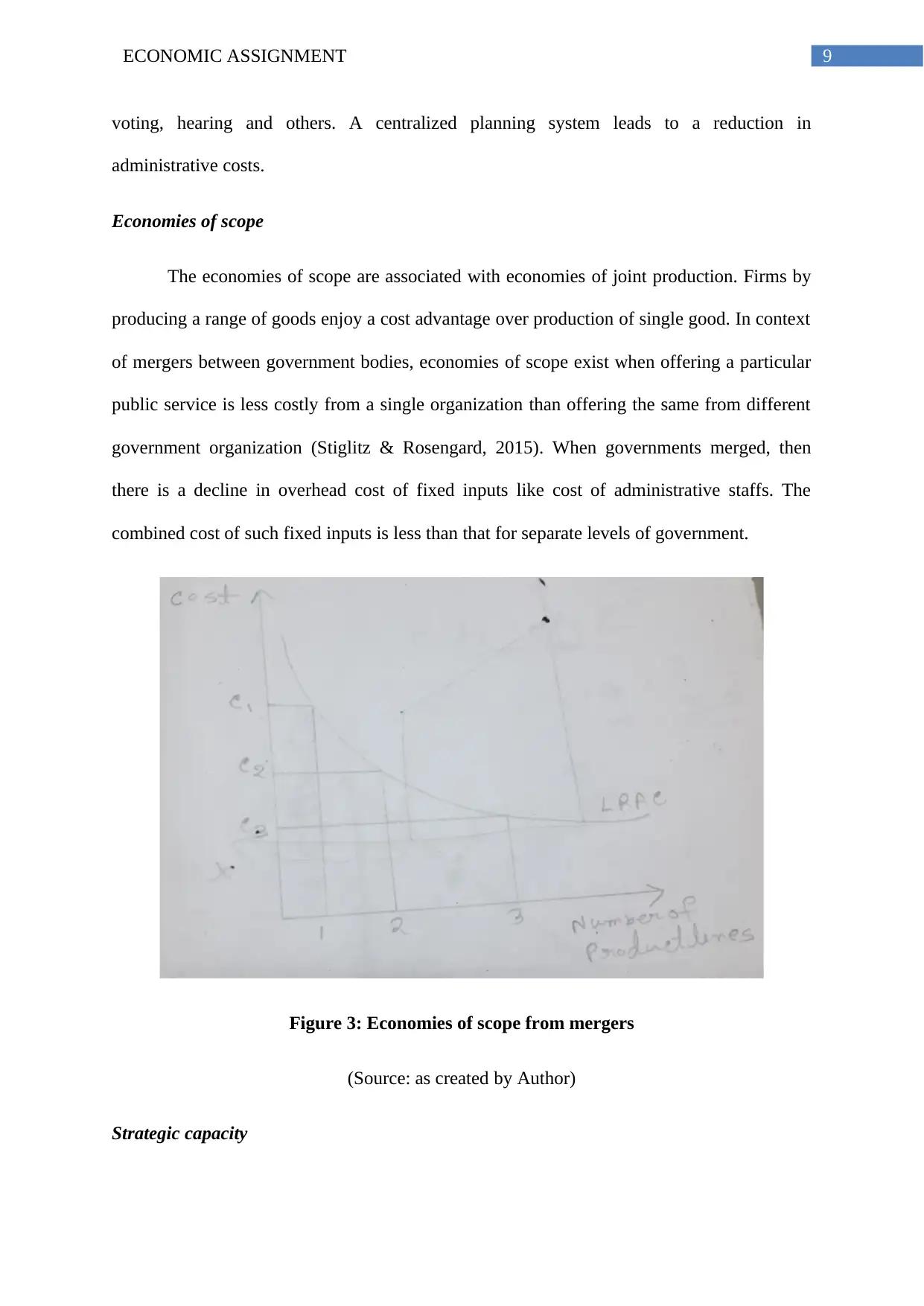
9ECONOMIC ASSIGNMENT
voting, hearing and others. A centralized planning system leads to a reduction in
administrative costs.
Economies of scope
The economies of scope are associated with economies of joint production. Firms by
producing a range of goods enjoy a cost advantage over production of single good. In context
of mergers between government bodies, economies of scope exist when offering a particular
public service is less costly from a single organization than offering the same from different
government organization (Stiglitz & Rosengard, 2015). When governments merged, then
there is a decline in overhead cost of fixed inputs like cost of administrative staffs. The
combined cost of such fixed inputs is less than that for separate levels of government.
Figure 3: Economies of scope from mergers
(Source: as created by Author)
Strategic capacity
voting, hearing and others. A centralized planning system leads to a reduction in
administrative costs.
Economies of scope
The economies of scope are associated with economies of joint production. Firms by
producing a range of goods enjoy a cost advantage over production of single good. In context
of mergers between government bodies, economies of scope exist when offering a particular
public service is less costly from a single organization than offering the same from different
government organization (Stiglitz & Rosengard, 2015). When governments merged, then
there is a decline in overhead cost of fixed inputs like cost of administrative staffs. The
combined cost of such fixed inputs is less than that for separate levels of government.
Figure 3: Economies of scope from mergers
(Source: as created by Author)
Strategic capacity
Paraphrase This Document
Need a fresh take? Get an instant paraphrase of this document with our AI Paraphraser
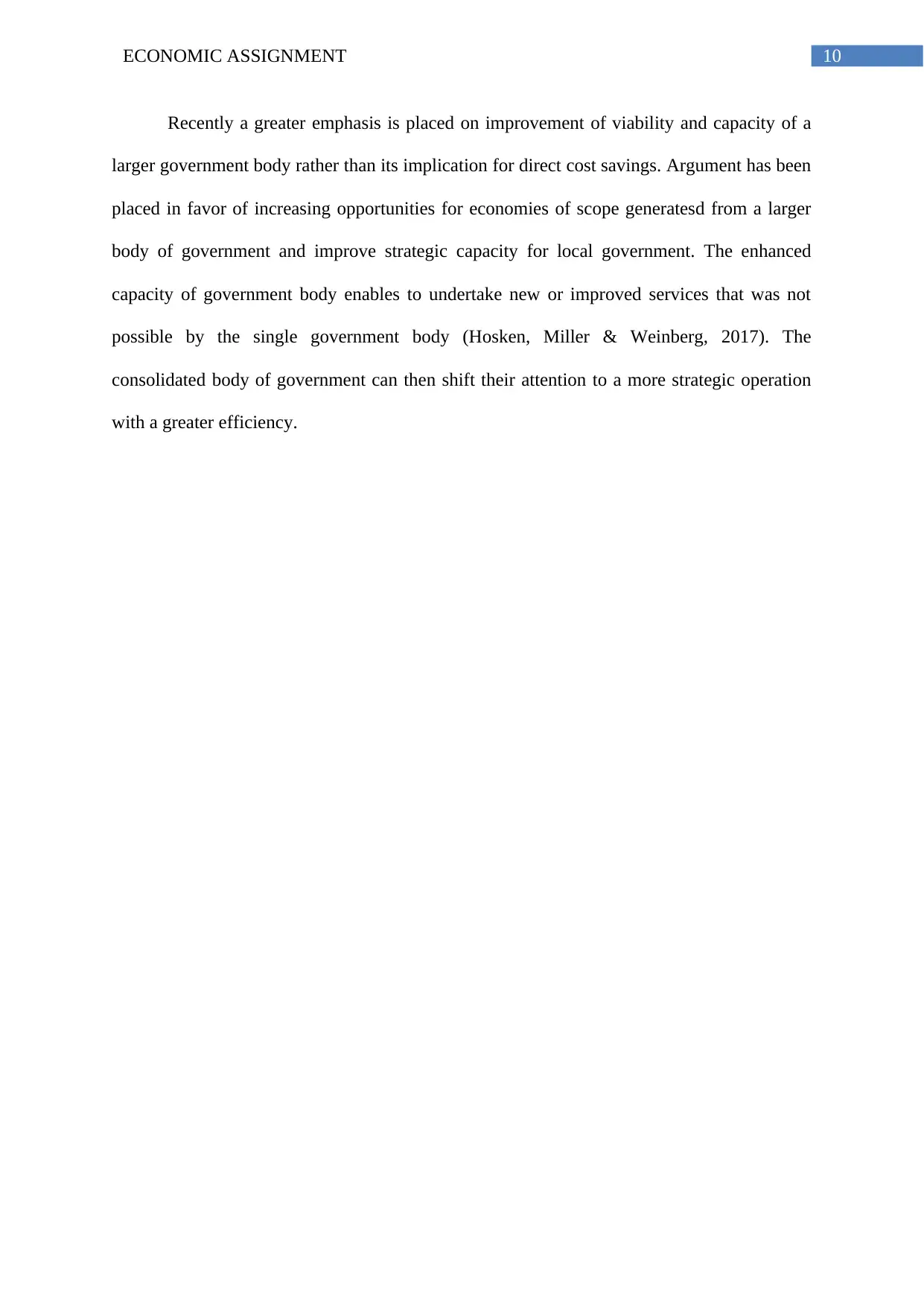
10ECONOMIC ASSIGNMENT
Recently a greater emphasis is placed on improvement of viability and capacity of a
larger government body rather than its implication for direct cost savings. Argument has been
placed in favor of increasing opportunities for economies of scope generatesd from a larger
body of government and improve strategic capacity for local government. The enhanced
capacity of government body enables to undertake new or improved services that was not
possible by the single government body (Hosken, Miller & Weinberg, 2017). The
consolidated body of government can then shift their attention to a more strategic operation
with a greater efficiency.
Recently a greater emphasis is placed on improvement of viability and capacity of a
larger government body rather than its implication for direct cost savings. Argument has been
placed in favor of increasing opportunities for economies of scope generatesd from a larger
body of government and improve strategic capacity for local government. The enhanced
capacity of government body enables to undertake new or improved services that was not
possible by the single government body (Hosken, Miller & Weinberg, 2017). The
consolidated body of government can then shift their attention to a more strategic operation
with a greater efficiency.
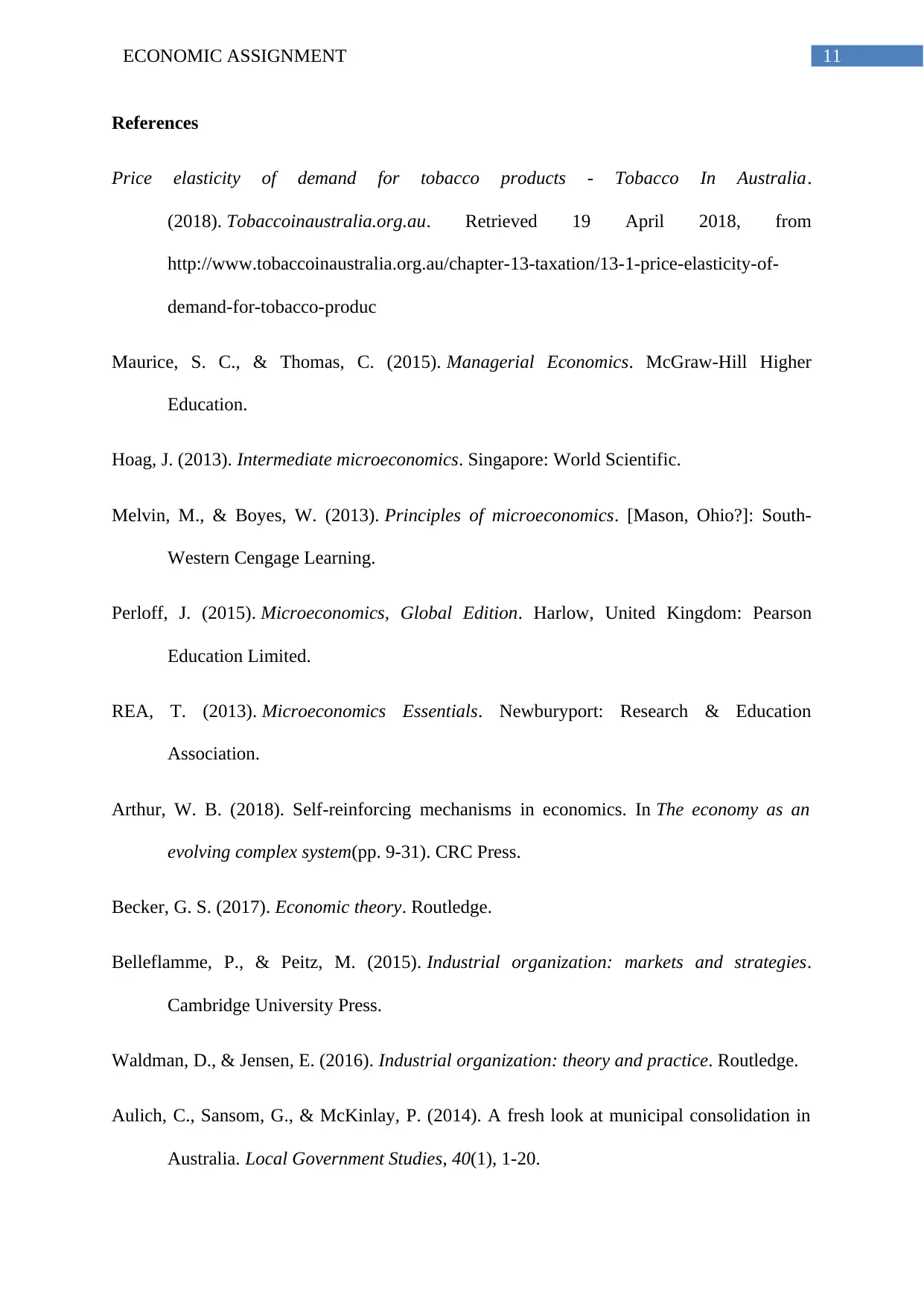
11ECONOMIC ASSIGNMENT
References
Price elasticity of demand for tobacco products - Tobacco In Australia.
(2018). Tobaccoinaustralia.org.au. Retrieved 19 April 2018, from
http://www.tobaccoinaustralia.org.au/chapter-13-taxation/13-1-price-elasticity-of-
demand-for-tobacco-produc
Maurice, S. C., & Thomas, C. (2015). Managerial Economics. McGraw-Hill Higher
Education.
Hoag, J. (2013). Intermediate microeconomics. Singapore: World Scientific.
Melvin, M., & Boyes, W. (2013). Principles of microeconomics. [Mason, Ohio?]: South-
Western Cengage Learning.
Perloff, J. (2015). Microeconomics, Global Edition. Harlow, United Kingdom: Pearson
Education Limited.
REA, T. (2013). Microeconomics Essentials. Newburyport: Research & Education
Association.
Arthur, W. B. (2018). Self-reinforcing mechanisms in economics. In The economy as an
evolving complex system(pp. 9-31). CRC Press.
Becker, G. S. (2017). Economic theory. Routledge.
Belleflamme, P., & Peitz, M. (2015). Industrial organization: markets and strategies.
Cambridge University Press.
Waldman, D., & Jensen, E. (2016). Industrial organization: theory and practice. Routledge.
Aulich, C., Sansom, G., & McKinlay, P. (2014). A fresh look at municipal consolidation in
Australia. Local Government Studies, 40(1), 1-20.
References
Price elasticity of demand for tobacco products - Tobacco In Australia.
(2018). Tobaccoinaustralia.org.au. Retrieved 19 April 2018, from
http://www.tobaccoinaustralia.org.au/chapter-13-taxation/13-1-price-elasticity-of-
demand-for-tobacco-produc
Maurice, S. C., & Thomas, C. (2015). Managerial Economics. McGraw-Hill Higher
Education.
Hoag, J. (2013). Intermediate microeconomics. Singapore: World Scientific.
Melvin, M., & Boyes, W. (2013). Principles of microeconomics. [Mason, Ohio?]: South-
Western Cengage Learning.
Perloff, J. (2015). Microeconomics, Global Edition. Harlow, United Kingdom: Pearson
Education Limited.
REA, T. (2013). Microeconomics Essentials. Newburyport: Research & Education
Association.
Arthur, W. B. (2018). Self-reinforcing mechanisms in economics. In The economy as an
evolving complex system(pp. 9-31). CRC Press.
Becker, G. S. (2017). Economic theory. Routledge.
Belleflamme, P., & Peitz, M. (2015). Industrial organization: markets and strategies.
Cambridge University Press.
Waldman, D., & Jensen, E. (2016). Industrial organization: theory and practice. Routledge.
Aulich, C., Sansom, G., & McKinlay, P. (2014). A fresh look at municipal consolidation in
Australia. Local Government Studies, 40(1), 1-20.
⊘ This is a preview!⊘
Do you want full access?
Subscribe today to unlock all pages.

Trusted by 1+ million students worldwide
1 out of 13
Related Documents
Your All-in-One AI-Powered Toolkit for Academic Success.
+13062052269
info@desklib.com
Available 24*7 on WhatsApp / Email
![[object Object]](/_next/static/media/star-bottom.7253800d.svg)
Unlock your academic potential
Copyright © 2020–2025 A2Z Services. All Rights Reserved. Developed and managed by ZUCOL.




